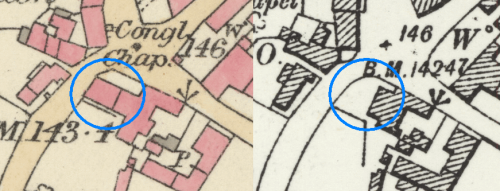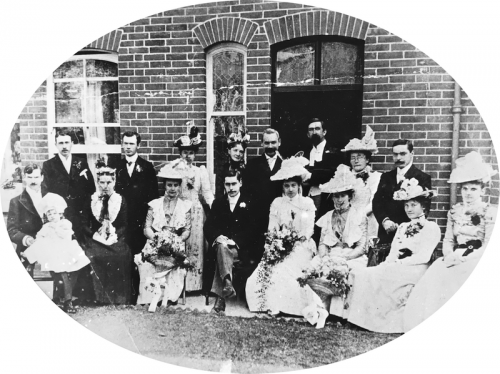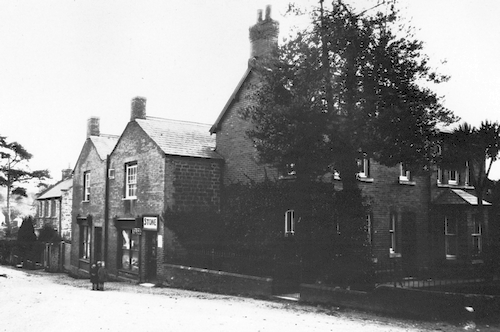The Netherbury Tithe Apportionment of 1839 identifies Elizabeth Shier as the owner and occupier of the two plots that make up the property now known as "The Redes". The main plot (635) was made up of "House, Garden & Orchard" and it was this house, fronting onto Bridge St, which went on to become a shop. The much smaller plot (636) just contained a house and pretty much occupied the current day lawn which lies inside the corner of Bridge St and St James Rd.
It is thought that the smaller plot was acquired from the estate of Mary Serjeant a few years before the Tithe Apportionment was written up and around the time the associated Tithe Map was drawn up (1835). This might explain why these two neighbouring and otherwise integrated pieces of land are recorded as two separate plots. Mary Serjeant had said in her will of 1833, that she wished a bundle of her properties to be sold "together and in one lot" and the proceeds passed on to her great niece (Mary Anna Denziloe). She went on to list the properties and added the phrase “together with any House or Buildings which I might hereafter erect or build at the corner of Shiers”.
It is very unlikely she finished any such project because she died less than a month after signing her will. An auction was advertised in the Dorset County Chronicle in April 1834 to sell the bundle of properties as she'd directed which included "A Very Thriving Young Orchard, situate in Netherbury Street, which comprises a convenient gig house, stable and part of a cottage newly built, the first floor joist, window frames, and door cases being completed, on which there is a well of excellent water."
Unfortunately the properties didn't reach what was considered a fair market price. No record has been found of what her executor, Richard Kiddle, actually did but some of the properties were made over to Mary Anna Denziloe and it is probable that some were sold off, individually, where a good enough price could be obtained for them. It is thought that Elizabeth (Betty) Shier purchased the small plot that abutted onto her property at this point and it was probably her that finished the house which is shown on the Tithe Map.
Prior to this the annual Land Tax records show Elizabeth (Betty) Shier paying 3s 7d as owner and occupier of a single plot running back to 1802. The records are incomplete but, before that they record Betty's husband John paying virtually the same for a single plot between 1784 and 1795. John died and was buried in Loders in 1798 and, although the Land Tax records do not record an address or identify the property, this strongly suggests that John and Betty had been the owner/occupiers of the Tithe Map's plot 635 since 1784.
John and Betty had married in Loders in 1776. They probably moved to Netherbury in 1784 when they had their newly born daughter Elizabeth and her one year old sister Sophia baptised in St Mary's on 17th September. Another girl, Anna Hanna, was born on Christmas Eve the following year and she was followed by Harriet a couple of years later in 1787.
The first proper census (1841) came after John had died and both Sophia & Anna had married and moved away leaving an 88 year old Betty as head of the household and her two remaining daughters Elizabeth and Harriet. This is also the first mention of the shop because Betty has "Shop M" entered as her "Profession, Trade or Employment".
The 1841 census also lists George Read, a tailor, living in Bridge Street and it is believed that he and his family had moved into the house that Betty Shier finished building after buying it from the estate of Mary Serjeant. Betty died in March 1844 and the two Shier sisters, Elizabeth and Harriet, are listed as shopkeepers, grocers and drapers in a couple of trade directories from the years 1849 & 1851. By the 1851 census the elder of the sisters, Elizabeth, is described as the head of the household and both she and Harriet are listed as Drapers. George Read is also listed, now described as "Tailor, Mercer" (a dealer in fine textiles and fabrics).
Elizabeth Shier died the next summer and the manorial records show that ownership passed to Vincent Thomas on 16th June 1854. Harriet Shier moved to Bradpole where she died in 1869 having stated in her will that she wanted to be buried in Loders alongside her parents and sisters.
The 1861 census appears to show the shop is now occupied by Mary Shugar "Shopkeeper Grocer & Draper". George Read is listed as just a Tailor once again.
In the summer of 1867 an advertisment appeared three weeks running in the Bridport News offering for sale "Premises situate in the centre of the village, in the occupation of Mrs Shugar" and asking anyone interested to "Apply to the owner , Mr Thomas Vincent". It is assumed that there was insufficient interest becuase Thomas Vincent remained the owner for another seven years.
When George Read died, aged just 53, in the autumn of 1867 he left everything to his widow, Sarah. Initially she tried to let the business with an advertisement appearing in the Dorset County Chronicle on 14th November
TO BE LET BY PRIVATE CONTRACT,
for a Term of 3, 5, or 7 years, with immediate possession,—All that DWELLING-HOUSE; comprising a shop, workshop, parlour, three bed-rooms, kitchen, and other offices and garden, situate in the middle of the Village of Netherbury, and late in the occupation of Mr. George Read, deceased, who for several years past successfully carried on the business of tailor therein.
The Tenant will be required to take the Stock-in-Trade of the late Mr. Read and the Fixtures at a Valuation, in the usual way. To view apply to Mrs. Read, on the Premises ; and for further particulars to Mr. Peter Cox, Solicitor, Beaminster.
Dated 9th November, 1867
It would appear that, once again, there was not sufficient interest because less than three months later the idea had been abandoned and Sarah's 18 year old son William was running the business. Just over three years later William married Elizabeth Sarah Goodchild and, according to the 1871 census, his mother moved out and was living on her own somewhere nearby, possibly next-door, in High St, Netherbury. Business must have been fairly good because when Mary Shugar's shop and Read's tailors were put up for auction in 1873 William took on the ownership of the properties and was granted "Admission" by the manor under a copyholdType of feudal land tenure
with duties and obligations
to the Lord of the Manor lease in November 1874.
Mary Shugar continued running the Grocer's/General store but eventually died in 1881. The census that year lists William Read as "Woollen Draper Grocer" so it would appear that by then he had taken over the shop business as well as owning the premises.
It was some time during the Reads ownership that the current, distinctive, red-brick, section of the house, facing onto St James Rd, was built. It's not known exactly when the work was carried out but there are two very detailed Ordnance Survey maps which were drawn from surveys in 1886 and 1901 and the house was remodelled between them. There is a common belief locally that the cottage started by Mary Serjeant and finished by Betty Shier burnt down but it has not been possible to find any evidence to support this. It may also be that the Reads moved their tailoring workrooms above the shop and wanted somewhere that made a bit more of a statement for their house.
At the time the design would have been considered very modern - the front walls are an early example of cavity wall construction and incorporate very early cast iron wall ties. Using brick was not the local norm and there were not many places manufacturing bricks in the area. Melplash Farm is one possibility, Bothenhampton another. The walls at the rear of the house are built with the more usual stone, probably reclaimed from the demolished cottage, which maybe underlines that the brick frontage was designed to make a statement.
It would appear that, when William retired, he and Elizabeth stayed on in the new, modern, house and the shop became a separate entity once more. The 1911 census lists William as "Retired Tailor & Shopkeeper" and John William & Hannah Lewis, both described as “Draper & Grocer”, are occupying the shop. John William is also listed as a Netherbury Grocer in the Kelly's Directories of 1911 & 1915.
William Read died in 1912 leaving the house to Elizabeth and she was still there a decade later as recorded in the Electoral Role of 1921. At some point over the next few years she sold the house and moved to live with her daughter in Birmingham which is where she died in 1927.
In 1939 the Standevan family, Albert, Annie and their younger son Jack, are recorded as living at The Redes in the England & Wales Register and this is the first record we have of the house with that name. It is thought they may have already been living there for a decade and there is a report in the Shepton Mallet Journal on 20th June 1930 recording that "Gordon Hugh Standeven, commercial traveller, Netherbury, Dorset" was fined a total of £5 15/- at Bridgwater Police Court for "driving a motor-cycle in a manner dangerous to the public, and for not stopping when requested". Gordon, his parents' first son, was born in Cheshire but just over a year later the 1911 Census lists them as living in Skegness, Lincolnshire where Albert was working as a Commercial Traveller, selling soap.
It is probable that the Standevans named the house "The Redes" linking it to its previous owners but the reason for the change of spelling is not known. The word Rede is an archaic term meaning advice or counsel.
The preceding entry in the 1939 Register is for the Stone family with Bessie Stone described as a Shopkeeper.
Over the next few decades various names are linked to The Redes - Winters, Trott, Walker & Harvey. The last shopkeeper was Mr Hindley who closed the shop in the late 1960s by which time there was a rival General Stores and Post Office a few metres down the hill. About a decade later the Harveys bought what had been The Store but was now called Stone Cottage and combined the two properties into one again.
Many thanks to Allan & Margaret Harvey for their help with compiling this page.




